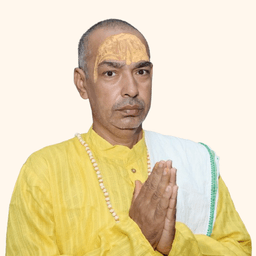Tulsi Vivah 2024 : Date, Celebration and Significance

About Tulsi Vivah
Hindus will commemorate the union of Goddess Tulsi and Lord Shaligram as the month of Kartik for 2024 draws to an end. It is said that Lord Vishnu emerges from a lengthy, almost four-months sleep on the day before Tulsi Vivah. The festival starts from the Dev Uthaan Ekadashi and continues till next day on dwadashi tithi when devotees perform Tulsi Vivah. The festival falls in the month of October or November on the shukla paksha tithi of kartik month. Although, the ceremony is conducted at any time during the day between Prabodhini Ekadashi (11th day) and Kartik Purnima. In some places, tulsi vivah is celebrated for five days which takes place on the Kartik month full moon day. Tulsi Vivah is considered to be the sign of the end of monsoon month and the start of the wedding season in India. Tulsi Vivah Vrat and puja is particularly performed by married women to get blessings for their marriage life. Apart from this, Tulsi vivah vrat blesses a person with wealth, longevity, good health and removes all the obstacles from a person’s life.
Hindus will commemorate the union of Goddess Tulsi and Lord Shaligram as the month of Kartik for 2024 draws to an end. It is said that Lord Vishnu emerges from a lengthy, almost four-months sleep on the day before Tulsi Vivah. The festival starts from the Dev Uthaan Ekadashi and continues till next day on dwadashi tithi when devotees perform Tulsi Vivah. The festival falls in the month of October or November on the shukla paksha tithi of kartik month. Although, the ceremony is conducted at any time during the day between Prabodhini Ekadashi (11th day) and Kartik Purnima. In some places, tulsi vivah is celebrated for five days which takes place on the Kartik month full moon day. Tulsi Vivah is considered to be the sign of the end of monsoon month and the start of the wedding season in India. Tulsi Vivah Vrat and puja is particularly performed by married women to get blessings for their marriage life. Apart from this, Tulsi vivah vrat blesses a person with wealth, longevity, good health and removes all the obstacles from a person’s life.
Tulsi Vivah 2024 Date and Puja Timings
The Kartik Shukla Paksha's Dwadashi Tithi this year takes place from November 12, 2024, at 4:04 PM to November 13, 2024, at 1:01 PM. It is predicted that Tulsi Vivah will be observed on November 13, 2024, the day of the tithi's sunrise. Devuthani Ekadashi, the day preceding, falls on November 12 and signifies the conclusion of Chaturmas.
The Kartik Shukla Paksha's Dwadashi Tithi this year takes place from November 12, 2024, at 4:04 PM to November 13, 2024, at 1:01 PM. It is predicted that Tulsi Vivah will be observed on November 13, 2024, the day of the tithi's sunrise. Devuthani Ekadashi, the day preceding, falls on November 12 and signifies the conclusion of Chaturmas.
Significance and History of Tulsi Vivah
Tulsi is considered to be the purest form of plant on earth which has ability to remove all the dark energies and negativity from the person and their houses. According to Skanda Purana, on the dwadashi tithi of kartik shukla paksha, Goddesses Tulsi and Lord Shaligram got married. Lord Shaligram is considered to be the incarnation of Lord Vishnu. According to Narada Purana, once upon a time in Dwapar Yuga, there was a demon named Jalandhar who was spreading massive destruction around the earth, hell and heaven. The demon was so powerful because his wife, Vrinda worships god for her husband on a daily basis. The time came when all the gods of heaven visited Lord Vishnu in his Vaikunth Dham to complain about the demon. There Lord Vishnu plans to break the fast of Vrinda which she religiously conducts for her husband. Afterwards, Lord Vishnu took on the form of Vrinda’s husband, Jalandhar, and approached her, causing her to unknowingly break her vow of fidelity (pativrata dharma). As a result, Jalandhar lost his protection and was killed in battle. When Vrinda learned the truth, she was deeply hurt and cursed Lord Vishnu to become the Shaligram stone and said that lord vishnu will also suffer the distance from his wife. After cursing lord vishnu, she sits on the cremation with the dead body of his husband and offers herself to death, where the tulsi plant. After that when Lord Vishnu realized that vrinda was at no fault, he promised her to become her husband for lifetime and blessed that whosoever will tie a knot of his shaligram form with tulsi on kartik shukla paksha dwadashi, he will give them wealth, health, prosperity and happy married life to the married womens.
Tulsi is considered to be the purest form of plant on earth which has ability to remove all the dark energies and negativity from the person and their houses. According to Skanda Purana, on the dwadashi tithi of kartik shukla paksha, Goddesses Tulsi and Lord Shaligram got married. Lord Shaligram is considered to be the incarnation of Lord Vishnu. According to Narada Purana, once upon a time in Dwapar Yuga, there was a demon named Jalandhar who was spreading massive destruction around the earth, hell and heaven. The demon was so powerful because his wife, Vrinda worships god for her husband on a daily basis. The time came when all the gods of heaven visited Lord Vishnu in his Vaikunth Dham to complain about the demon. There Lord Vishnu plans to break the fast of Vrinda which she religiously conducts for her husband. Afterwards, Lord Vishnu took on the form of Vrinda’s husband, Jalandhar, and approached her, causing her to unknowingly break her vow of fidelity (pativrata dharma). As a result, Jalandhar lost his protection and was killed in battle. When Vrinda learned the truth, she was deeply hurt and cursed Lord Vishnu to become the Shaligram stone and said that lord vishnu will also suffer the distance from his wife. After cursing lord vishnu, she sits on the cremation with the dead body of his husband and offers herself to death, where the tulsi plant. After that when Lord Vishnu realized that vrinda was at no fault, he promised her to become her husband for lifetime and blessed that whosoever will tie a knot of his shaligram form with tulsi on kartik shukla paksha dwadashi, he will give them wealth, health, prosperity and happy married life to the married womens.
Rituals and Traditions of Tulsi Vivah
Wedding season officially starts from the day of tulsi vivah. It is considered auspicious to get married on the day of tulsi vivah itself. Married womens observe fast which starts when dwadashi tithi takes place and can be broken only after the wedding ceremony of tulsi and shaligram in the evening. In the early morning during brahma muhurta, devotees take bath and dress up with fresh clothes. Afterwards, they give a bath to goddess tulsi and dress her up with bridal saree, dupatta and other jewelry items. In the evening, people build a small mandap inside their houses or temples and decorate it with flowers, rangoli and lights. Lord shaligram is dressed up with white or yellow dhoti. A priest performs puja and mantras after tying the knot between tulsi and shaligram. Devotees enjoy by offering flowers and rice to the couple. At the end, prashad is distributed among devotees.
Wedding season officially starts from the day of tulsi vivah. It is considered auspicious to get married on the day of tulsi vivah itself. Married womens observe fast which starts when dwadashi tithi takes place and can be broken only after the wedding ceremony of tulsi and shaligram in the evening. In the early morning during brahma muhurta, devotees take bath and dress up with fresh clothes. Afterwards, they give a bath to goddess tulsi and dress her up with bridal saree, dupatta and other jewelry items. In the evening, people build a small mandap inside their houses or temples and decorate it with flowers, rangoli and lights. Lord shaligram is dressed up with white or yellow dhoti. A priest performs puja and mantras after tying the knot between tulsi and shaligram. Devotees enjoy by offering flowers and rice to the couple. At the end, prashad is distributed among devotees.
Disclaimer:
The above-provided information is based on various researches, facts may vary as per traditional customs and region. Kindly consult before performing the rituals.
The above-provided information is based on various researches, facts may vary as per traditional customs and region. Kindly consult before performing the rituals.















































































